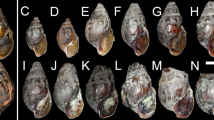Abstract
Paired comparison models can be used to study the order of stratigraphic events along a relative time scale when differences in order are observed to occur in stratigraphic sections or wells. They give parameters of (1) a binomial distribution for the probability that a given event occurred earlier than another event, or (2) a trinomial distribution for the probability of earlier, later, or simultaneous occurrences of events. In the Bradley-Terry and Davidson models differences in positions of events along a logarithmic scale are assumed to satisfy a logistic frequency distribution. In the recently developed RASC model, a normal frequency distribution along a linear scale is used. The properties of these three models are reviewed and computer algorithms used to obtain practical solutions are discussed. The three models have each been applied to three published data sets (10 highest and lowest occurrences of Eocene nannofossils in 9 wells in California; 16 lowest occurrences of Cambrian trilobites and other fossils in 7 stratigraphic sections in Texas; and 41 highest occurrences of Cenozic foraminifera and other microfossils in 16 wells, Canadian Atlantic Margin). Results of the three models are not significantly different. However, only the RASC model can be applied to large data sets because its computer algorithm avoids the use of timeconsuming iterative processes required when other models are used.
Similar content being viewed by others
References
Agterberg, F. P. and Gradstein, F. M., 1981, Workshop on quantitative stratigraphic correlation techniques; Math. Geol., v. 13, no. 1, p. 81–91.
Agterberg, F. P. and Nel, L. D., 1982, Algorithms for the scaling of stratigraphic events. Comput. Geosci., v. 8, no. 2.
Bradley, R. A., 1953, Some statistical methods in taste testing and quality evaluation: Biometrics, v. 9, no. 1, p. 22–38.
Bradley, R. A. and Terry, M. E., 1952, Rank analysis of incomplete block designs, I, The method of paired comparisons: Biometrika, v. 39, parts 3 and 4, p. 324–345.
Brower, J. C., 1981, Quantitative biostratigraphy, 1830–1980;in D. F. Merriam (ed.), Computer applications in the earth sciences, an update for the 70's: Plenum, New York, p. 63–103.
Brunk, H. D., 1960, Mathematical models for ranking from paired comparisons: Jour. Amer. Stat. Assoc., v. 55, p. 503–520.
David, H. A., 1963, The method of paired comparisons: Griffin, London, 124 p.
Davidson, R. R., 1970, On extending the Bradley-Terry model to accomodate ties in paired comparison experiments: Jour. Amer. Stat. Assoc., v. 65, no. 329, p. 317–328.
Edwards, L. E. and Beaver, R. J., 1978, The use of paired comparison model in ordering stratigraphic events: Math. Geol., v. 10, no. 3, p. 261–272.
Glenn, W. A. and David, H. A., 1960, Ties in paired-comparison experiments using a modified Thurstone-Mosteller model: Biometrics, v. 16, no. 1, p. 86–109.
Gradstein, F. M. and Agterberg, F. P., in press, Statistical models of Cenozoic foraminiferal stratigraphy—Northwestern Atlantic margin: Proc. 26th Internat. Geol. Congr., Paris, 1980.
Hald, A., 1952, Statistical tables and formulas (Wiley Publications in Statistics): Wiley, New York, 97 p.
Hay, W. W., 1972, Probabilistic stratigraphy: Ecologae Geologicae Helvetiae, v. 65, no. 2, p. 255–266.
Johnson, N. L. and Kotz, S., 1970, Distributions in statistics: Continuous univariate distributions, v. 2: Houghton-Mifflin, Boston, Mass., 306 p.
Kendall, M., 1975, Rank correlation methods: Griffin, London, 202 p.
Mosteller, F., 1951, Remarks on the method of paired comparisons, I, The least squares solution assuming equal standard deviations and equal correlations: Psychometrika, v. 16, no. 1, p. 3–9.
Owen, D. B., 1962, Handbook of statistical tables: Addison-Wesley, Reading, Mass., p. 254–258.
Palmer, A. R., 1955, The faunas of the Riley Formation in central Texas: Jour. Paleontol., v. 28, no. 6, p. 709–786.
Rao, P. V. and Kupper, L. L., 1967, Ties in paired-comparison experiments: A generalization of the Bradley-Terry model: Jour. Amer. Stat. Assoc., v. 62, no. 1, p. 194–204. Corrigenda, v. 63, no. 4, p. 1550.
Shaw, A. B., 1964, Time in stratigraphy: McGraw-Hill, New York, 365 p.
Sullivan, F. R., 1965, Lower Tertiary Nannoplankton from the California Coast Ranges, II, Eocene: Univ. Calif. Publ. Geological Sciences, v. 53, p. 1–52.
Thurstone, L. L., 1927, Psychophysical analysis: Amer. Jour. Psychol., v. 38, p. 368–389.
Torgerson, W. S., 1958, Theory and methods of scaling: Wiley, New York, 460 p.
Worsley, T. R. and Jorgens, M. L., 1977, Automated biostratigraphy,in A. T. S. Ramsay (ed.), Oceanic micropaleontology: Academic Press, London, v. 2, p. 1201–1229.
Zermelo, E., 1929, Die Berechnung der Turnier-Ergebnisse als ein Maximumproblem der Wahrscheinlichkeitsrechnung: Mathematische Zeitschrift, v. 29, p. 436–460.
Author information
Authors and Affiliations
Additional information
Contribution to International Geological Correlation Programme Project 148, (Quantitative Stratigraphic Correlation Techniques). Manuscript received 23 March 1981; revised 6 October 1981.
Rights and permissions
About this article
Cite this article
Hudson, C.B., Agterberg, F.P. Paired comparison models in biostratigraphy. Mathematical Geology 14, 141–159 (1982). https://doi.org/10.1007/BF01083949
Received:
Revised:
Issue Date:
DOI: https://doi.org/10.1007/BF01083949




